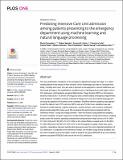Predicting intensive care unit admission among patients presenting to the emergency department using machine learning and natural language processing
Author(s)
Finkelstein, Stan Neil
DownloadPublished version (1.724Mb)
Publisher with Creative Commons License
Publisher with Creative Commons License
Creative Commons Attribution
Terms of use
Metadata
Show full item recordAbstract
The risk stratification of patients in the emergency department begins at triage. It is vital to stratify patients early based on their severity, since undertriage can lead to increased morbidity, mortality and costs. Our aim was to present a new approach to assist healthcare professionals at triage in the stratification of patients and in identifying those with higher risk of ICU admission. Adult patients assigned Manchester Triage System (MTS) or Emergency Severity Index (ESI) 1 to 3 from a Portuguese and a United States Emergency Departments were analyzed. Variables routinely collected at triage were used and natural language processing was applied to the patient chief complaint. Stratified random sampling was applied to split the data in train (70%) and test (30%) sets and 10-fold cross validation was performed for model training. Logistic regression, random forests, and a random undersampling boosting algorithm were used. We compared the performance obtained with the reference model-using only triage priorities-with the models using additional variables. For both hospitals, a logistic regression model achieved higher overall performance, yielding areas under the receiver operating characteristic and precision-recall curves of 0.91 (95% CI 0.90-0.92) and 0.30 (95% CI 0.27-0.33) for the United States hospital and of 0.85 (95% CI 0.83-0.86) and 0.06 (95% CI 0.05-0.07) for the Portuguese hospital. Heart rate, pulse oximetry, respiratory rate and systolic blood pressure were the most important predictors of ICU admission. Compared to the reference models, the models using clinical variables and the chief complaint presented higher recall for patients assigned MTS/ESI 3 and can identify patients assigned MTS/ESI 3 who are at risk for ICU admission.
Date issued
2020-03Department
Massachusetts Institute of Technology. Institute for Data, Systems, and SocietyJournal
PLoS ONE
Publisher
Public Library of Science (PLoS)
Citation
Fernandes, Marta et al. “Predicting intensive care unit admission among patients presenting to the emergency department using machine learning and natural language processing,” PLoS ONE, vol. 15, no. 3, 2020, e0229331 © 2020 The Author(s)
Version: Final published version
ISSN
1932-6203